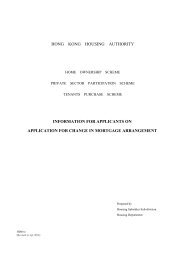Empowerment Games: Community participation and sustainable
Empowerment Games: Community participation and sustainable
Empowerment Games: Community participation and sustainable
You also want an ePaper? Increase the reach of your titles
YUMPU automatically turns print PDFs into web optimized ePapers that Google loves.
<strong>Empowerment</strong> <strong>Games</strong>: <strong>Community</strong> <strong>participation</strong> <strong>and</strong> <strong>sustainable</strong> public<br />
housing development in the social context of Hong Kong<br />
Ms. CHU Shuk Fan, Centre-In-Charge, Hong Kong Sheng Kung Hui Ngau Tau Kok<br />
<strong>Community</strong> Development Centre,<br />
The Lower Ngau Tau Kok (II) Estate Redevelopment Concern Group <strong>and</strong> the Elderly Flats<br />
Concern Group,<br />
Ms. LEE Yan Ki, PhD C<strong>and</strong>idate, School of Design, The Hong Kong Polytechnic University,<br />
Dr. KU Hok Bun, Assistant Professor, Department of Applied Social Sciences, The Hong<br />
Kong Polytechnic University, <strong>and</strong><br />
Mr. Timothy JACHNA, Assistant Professor, School of Design, The Hong Kong Polytechnic<br />
University, HKSAR<br />
Abstract<br />
The paper is a case study in community <strong>participation</strong> in housing development in Hong Kong,<br />
documenting the community <strong>participation</strong> process from the perspectives of different<br />
collaborators such as social scientists/academics, facilitators with different backgrounds such<br />
as design <strong>and</strong> social work, <strong>and</strong> participating resident groups. The paper aims at demonstrating<br />
how local citizens have become actively involved in an urban redevelopment program to<br />
achieve re-housing to a location near their current estate, <strong>and</strong> to formulate <strong>and</strong> express their<br />
comments <strong>and</strong> suggestions for a more appropriate future living environment. Through a series<br />
of workshops, these citizens participated in underst<strong>and</strong>ing <strong>and</strong> commenting on the design of<br />
their future estate which is going to be built at a location of their choosing, after three-years<br />
negotiation of relocating to a nearby “reception” estate.<br />
1. Introduction - Social content of public <strong>participation</strong> in Hong Kong<br />
Realising that the sense of community is vanishing rapidly as a consequence of the type of<br />
urban redevelopment which has been practiced in Hong Kong, as in many other cities, the<br />
Hong Kong government has adopted community development as one of the main social<br />
welfare strategies to improve the quality of life in the city through measures aimed at<br />
restoring a lost sense of community. This has become a principal strategy of the <strong>Community</strong><br />
Development Programme of the Hong Kong Social Welfare Department as stated at their<br />
website: “to promote social relationship <strong>and</strong> cohesion within the community, <strong>and</strong> to<br />
encourage the <strong>participation</strong> of individuals in solving community problems <strong>and</strong> improving the<br />
quality of community life.” All these community <strong>participation</strong> projects aim at improving<br />
people’s lives by involving specific users in the process of creating their living environments.<br />
However, there are many possible interpretations of the appropriate methods <strong>and</strong> applications<br />
of such a “bottom-up” approach. This paper documents a series of community <strong>participation</strong><br />
activities, which constitute a process of collaboration between different facilitators such as<br />
social workers <strong>and</strong> architectural designers working intensively with residents groups.<br />
© 2004, LEE Yan Ki, CHU Shuk Fan, Dr. KU Hok Bun, Timothy JACHNA, HKSAR<br />
All rights reserved. No part of this paper may be reproduced, distributed, published, or transmitted<br />
without the prior permission of the copyright owner.
2<br />
2. Start-up process of community <strong>participation</strong> – a social worker/ facilitator’s<br />
perspective<br />
2.1.The community profile of the Lower Ngau Tau Kok Estate (II) 1<br />
The Hong Kong Sheng Kung Hui Ngau Tau Kok <strong>Community</strong> Development Centre<br />
(NTKCDC) commenced the <strong>Community</strong> Development Service in February 2000 to serve<br />
residents of Block 8-14 of Lower Ngau Tau Kok Estate (II), one of the oldest public housing<br />
estates in Hong Kong. The estate was built in 1967, comprising about 4,500 households, with<br />
a combined population of 11,000. Over 30% of the residents were elderly, living either alone<br />
or as couples. It was listed as one of the estates to be redeveloped in the course of the<br />
Five-Year Program under the Comprehensive Redevelopment Program (CRP) 2 of the Hong<br />
Kong Housing Authority, <strong>and</strong> was originally announced to be cleared in 2003-2004.<br />
2.2. Background of residents’ <strong>participation</strong> in Lower Ngau Tau Kok Estate (II)<br />
The NTKCDC assisted the residents in various matters arising from the resettlement plans,<br />
including ensuring that the residents be re-housed in a location near their former home. After<br />
more than two years of effort, the Hong Kong Housing Authority decided on June 7, 2002<br />
that the residents of Lower Ngau Tau Kok Estate (II) would be re-housed at the existing<br />
Upper Ngau Tau Kok Estate site. The clearance plan was also postponed to 2008-2009, to<br />
correspond with the completion of the reception estate on the said site. Thus, Lower Ngau<br />
Tau Kok Estate (II) would become the ‘historical symbol’ of the end of the Hong Kong<br />
Housing Authority’s Comprehensive Redevelopment Plan (CRP).<br />
2.3. The achievement of the <strong>participation</strong> process<br />
This was a significant achievement by the residents’ group, not only because they would be<br />
re-housed in nearby reception estate, but also because they got a reflection on their attitudes<br />
<strong>and</strong> values in concerning the community affairs. Looking back on the beginning of this<br />
<strong>participation</strong> process, some residents recall feeling sceptical that the Housing Department<br />
would be at all receptive to residents’ expressing their needs <strong>and</strong> opinions. The general<br />
opinion seemed to be that the authority would not consider the residents’ voices as it already<br />
had its own comprehensive plan <strong>and</strong> policy for the re-housing process. Other residents were<br />
merely complacent <strong>and</strong> trusted blindly in the Housing Department to arrange for their<br />
resettlement. However, there were some residents with an interest in influencing their future,<br />
who felt helpless that they did not know how to express their opinions <strong>and</strong> let the Housing<br />
Department hear their voices.<br />
Through two years of rational <strong>and</strong> amicable negotiation with the Housing Authority, the<br />
residents came to realise that they have the right <strong>and</strong> indeed the responsibility to express their<br />
opinions <strong>and</strong> preferences to the Authority. Throughout the <strong>participation</strong> process, they became<br />
more aware of their identity as members of Ngau Tau Kok Estate <strong>and</strong> were encouraged to<br />
participate in solving community problems <strong>and</strong> improving the quality of community life.<br />
Furthermore, they have developed a sense of belonging <strong>and</strong> a realisation of their vested<br />
1 The Lower Ngau Tau Kok Estate has 14 blocks of public housing buildings, including Block 1-7 (Zone I) <strong>and</strong><br />
Block 8-14 (Zone II). The Zone I have been cleared in June, 2003.<br />
2 In 1985, the Comprehensive Redevelopment Program was extended to clear sub-st<strong>and</strong>ard blocks built in the<br />
60’s began.<br />
© 2004, LEE Yan Ki, CHU Shuk Fan, Dr. KU Hok Bun, Timothy JACHNA, HKSAR<br />
All rights reserved. No part of this paper may be reproduced, distributed, published, or transmitted<br />
without the prior permission of the copyright owner.
3<br />
interest in the redevelopment process.<br />
At the same time, they have learned how to express their opinion as well as provide<br />
information <strong>and</strong> collect opinions from the community. In the beginning phase, the group had<br />
a strong agreement that they should collect the residents’ opinions about the reception estate<br />
<strong>and</strong> delay of the clearance date. They understood that they were only a small subset of all the<br />
residents of the estate, <strong>and</strong> that their opinions would not necessarily represent the opinion of<br />
a majority of all residents. Hence, the Centre assisted the concern group in launching a<br />
survey <strong>and</strong> a series of residents’ meetings in order to collect opinions on resettlement,<br />
especially the location of reception estate. Over 2,500 questionnaires were collected <strong>and</strong> the<br />
result showed that over 93% of residents preferred to be re-housed at a location near to their<br />
current home. The concern group then met with concerned parties, such as the Committee of<br />
the Housing Authority, the officials of the Housing Department, the Legislative Councillors<br />
<strong>and</strong> the District Council, in order to have a direct dialogue. In the course of these negotiations,<br />
the group members learned how to have a sincere <strong>and</strong> rational communication with the<br />
concerned parties in order to arrive at a compromise with the authorities concerning this issue.<br />
In the end, the Housing Authority was convinced to adjust the clearance plan in order to<br />
accommodate the requests from affected residents.<br />
As stated by ex-chairman of the Housing Authority, Dr. Cheng Hon-kwan, the adjustment of<br />
the clearance plan was made to accommodate affected tenants who had indicated their strong<br />
preference to be re-housed in the Upper Ngau Tau Kok Estate Phase 2 <strong>and</strong> 3, rather than the<br />
originally-planned reception estate in the South East Kowloon Development Area. “Many of<br />
the tenants at Lower Ngau Tau Kok Estate are elderly who may have adjustment problems in<br />
a new neighbourhood. They have put to us many times before that they do not mind waiting a<br />
longer period for their re-housing to a reception estate nearby,” Dr Cheng said. 3<br />
The residents recognized that they were being treated with respect by the Housing Authority.<br />
Their efforts at rational negotiation over the past two years were fuelled by collective faith<br />
<strong>and</strong> rewarded with an enhanced underst<strong>and</strong>ing of how, through active <strong>participation</strong>, they<br />
could have a real effect on design issues that affect their daily lives.<br />
Another positive effect of the participatory process was to foster an awareness <strong>and</strong> concern<br />
for redevelopment <strong>and</strong> community issues amongst the residents. In the course of the exercise,<br />
they strengthened their neighborhood network <strong>and</strong> became more concerned about the needs<br />
of the elderly singles <strong>and</strong> couples. In the subsequent planning of the reception estate, the<br />
residents put a special focus on developing an ‘elderly-friendly community’.<br />
2.4. The beginning of active <strong>participation</strong> in planning the reception estate<br />
After the confirmation of the reception estate, the concern groups started a discussion about<br />
why <strong>and</strong> how to get involved in the planning of their future community. As with the issue of<br />
resettlement, the group members initially felt impotent to influence their future homes by<br />
<strong>participation</strong>. They admitted that they had a lack of information <strong>and</strong> difficulty in<br />
underst<strong>and</strong>ing abstract design concepts. In their past experience, the design of all flats <strong>and</strong><br />
3 The statement quoted from the press release of the Hong Kong Housing Authority in 7 th June 2002, topic of<br />
the release “Comprehensive Redevelopment Program Adjusted”.<br />
© 2004, LEE Yan Ki, CHU Shuk Fan, Dr. KU Hok Bun, Timothy JACHNA, HKSAR<br />
All rights reserved. No part of this paper may be reproduced, distributed, published, or transmitted<br />
without the prior permission of the copyright owner.
4<br />
community spaces was determined by the experts of the Housing Department. The residents<br />
believed that the experts with their professional knowledge should underst<strong>and</strong> <strong>and</strong><br />
accommodate the needs of the residents. They seldom questioned the design of these spaces.<br />
However, after undergoing a process of gaining underst<strong>and</strong>ing of the design of their future<br />
homes, they were able to point out bad <strong>and</strong> good aspects of the new estate. For example, they<br />
objected to long staircases <strong>and</strong> sloped pavements <strong>and</strong> preferred outdoor facilities to be<br />
covered. They criticized some designs as not having considered the users’ needs, especially<br />
those of the elderly.<br />
Members of both the elderly group <strong>and</strong> the concern group have paid several visits to other<br />
new flats, evoking many insights into issues in the interior design of the elderly flats <strong>and</strong> the<br />
design of the community facilities. For example, the height of the window, the linear kitchen<br />
stove, the place for hanging clothes, the size of the living area for two elderly residents <strong>and</strong><br />
the h<strong>and</strong>rails for the h<strong>and</strong>icapped elderly. After the visits, they realized the importance of<br />
their <strong>participation</strong> in the planning. If architects <strong>and</strong> designers were to underst<strong>and</strong> more about<br />
the daily lives of the future users, they could design household areas as well as community<br />
facilities based on the realities of the users lives.<br />
With the assistance of the designer <strong>and</strong> architect of the project, we organized several<br />
workshops for the residents to underst<strong>and</strong> the design of their future estate. The aim was to<br />
help the residents become aware of their needs related to the design of the flats <strong>and</strong> the<br />
community spaces. The workshop asked residents to give comments on photographs of<br />
situations in other estates <strong>and</strong> used the responses as a catalyst for further discussion.<br />
Date Schedule Content<br />
8/2002-10/2002 The elderly group<br />
reorganized to form a new<br />
group named “Elderly Flats<br />
Concern Group”<br />
The group members visited<br />
different new estates in Tai<br />
Hang Tung, Upper Ngau Tau<br />
Kok Estate Phase I <strong>and</strong> Yau<br />
Tong Estate, in order to<br />
underst<strong>and</strong> the internal design<br />
of the elderly household units.<br />
18/11/02-13/2/0<br />
3<br />
To submit an enquiry letter to Kwun Tong District<br />
Council <strong>and</strong> the Housing Department about the future<br />
plan of the reception estate<br />
3/2003-5/2003 To invite the officials of the Housing Department to<br />
have a meeting to discuss the questions of the reception<br />
estate<br />
The group received an initial<br />
reply from the Housing<br />
Department, to have a rough<br />
information about the reception<br />
estate<br />
Due to the disasters of SARS,<br />
the invitation was turned down<br />
14/6/2003 To invite another meeting with the Director of Housing<br />
Department, Mr Leung Chin Man<br />
© 2004, LEE Yan Ki, CHU Shuk Fan, Dr. KU Hok Bun, Timothy JACHNA, HKSAR<br />
To urge for a meeting that the<br />
group can reflect their opinions<br />
to the Department<br />
6/2003 To distribute a leaflets to introduce the new reception Collect about 330<br />
All rights reserved. No part of this paper may be reproduced, distributed, published, or transmitted<br />
without the prior permission of the copyright owner.
5<br />
estate <strong>and</strong> have a questionnaire to invite the residents’<br />
to join the briefing session<br />
7/2003 The group members divided into two small groups to<br />
visit the new estate in Yau Tong Estate, Lei Yue Mun<br />
Estate <strong>and</strong> Po Tat Estate<br />
questionnaires showed that<br />
they were interested in<br />
knowing more about the new<br />
reception estate<br />
To take pictures of three new<br />
estate, <strong>and</strong> to pay visits to the<br />
households living there about<br />
their opinions towards the<br />
community design <strong>and</strong><br />
facilities<br />
18/7/2003 To have a meeting with the Assistant Director of<br />
Housing Department, Mr Tong Wing Shing<br />
To have a good <strong>and</strong> sincere<br />
dialogue with the Department<br />
officials, to express the initial<br />
ideas <strong>and</strong> clarify the design of<br />
the new reception estate<br />
13/8/2003 To have a meeting with<br />
the Subsidized Housing<br />
Committee members<br />
To reflect the objection of<br />
“Deletion of Metal Gates of<br />
Future Public Housing Units”<br />
8/2003 Designed three awareness workshops for the group<br />
members to underst<strong>and</strong> the ideas of<br />
the new reception estate<br />
To help the group members to<br />
undergo the knowing <strong>and</strong><br />
preparation process in<br />
introducing the new reception<br />
estate<br />
9/2003 to<br />
28/11/03<br />
To prepare 8-10 times briefing sessions of the new<br />
reception estate, for about 250 residents, aims at<br />
providing information, facilitating <strong>and</strong> collecting<br />
opinions from other residents.<br />
To contact the residents from<br />
the questionnaire lists <strong>and</strong><br />
break into small groups for the<br />
briefing sessions<br />
Fig 1. The timeline of the <strong>participation</strong> process in planning <strong>and</strong> design of the reception estate_ Lower Ngau Tau<br />
Kok Estate (II) Redevelopment Concern Group <strong>and</strong> Elderly Flats Concern Group<br />
© 2004, LEE Yan Ki, CHU Shuk Fan, Dr. KU Hok Bun, Timothy JACHNA, HKSAR<br />
All rights reserved. No part of this paper may be reproduced, distributed, published, or transmitted<br />
without the prior permission of the copyright owner.




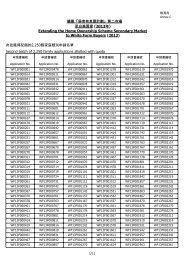

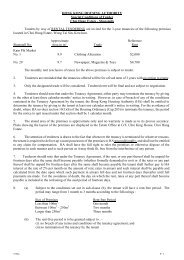
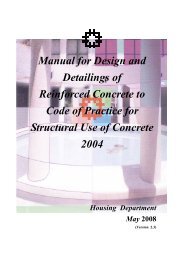


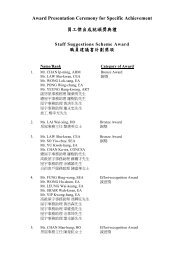
![Information for Applicants [HD273] (PDF format)](https://img.yumpu.com/34257587/1/184x260/information-for-applicants-hd273-pdf-format.jpg?quality=85)
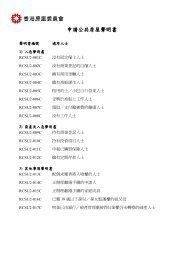

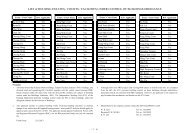
![å
¬å±è¼ªååç³è«é ç¥[HD274] (PDF æ ¼å¼) - é¦æ¸¯æ¿å±å§å¡æåæ¿å±ç½²](https://img.yumpu.com/31499087/1/184x260/aae-1-4-aacee-chd274-pdf-ae-1-4-a-1-4-eaeaeaaaaeaaeac-1-2-.jpg?quality=85)
